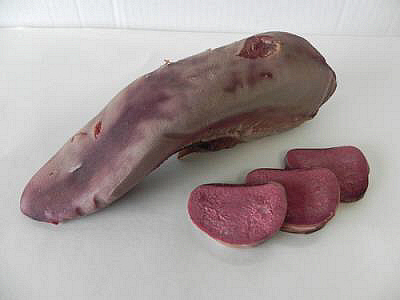

|
 Beef tongues, dried and smoked to preserve them. In common usage from about 1550 to 1790. WM 1658 has them salted with ordinary salt and saltpetre (E252), dried until stiff, then rolled in bran by the fire. There are receipts in Family Guide 1747 and Acton 1845. Foods of England has lots more about Tongue...  Modern (Pennsylvania Dutch) Smoked Tongue Image: http://www.dietrichsmeats.com They were noted by the pioneer scientist Sir Francis Bacon who made a particular study of preserving food - a study which may have cost him his life when he spent too long stuffing a fowl with snow in an experiment into freezing, and contracted a fatal case of pneumonia. They certainly last well. Our correspondent Sumner G. Hunnewell, Governor of the Society of Mayflower Descendants in the State of Missouri, USA, sent us this, from the Pilgrim's journal known as 'Mourt’s Relation' (ed. Dexter, 1865, 81-82), written just a few months after the pioneer settlers arrived in North America from England; “Wedneſday the 21. of February [1621], the maſter came on ſhore with many of his Saylers, and brought with him one of the great Peeces, called a Minion, and helped vs to draw it vp the hill, with another Peece that lay on ſhore, and mounted them, and a ſaller [ſaker] and two baſes; he brought with him a very fat Gooſe to eate with vs and we had a fat Crane, and a Mallerd, and a dry’d neats-tongue, ſo wee were kindly and friendly together.” Shakespeare's Merchant of Venice has "Silence is onely commendable In a neates tongue dried."  Original Receipt in WM 1658; Original Receipt in WM 1658;To dry Neats Tongues. Take Bay salt beaten very fine, and Salt-Peeter of each a like, and rub your Tongues very well with that, and cover all over with it, and as it wasts put on more, and when they are very hard and stiffe they are enough, then rowle them in Bran, and dry them before a soft fire, and before you boyle them, let them lie one night in Pompe Water, and boyle them in the same sort of water.  Original Receipt in 'The Accomplisht Cook ' by Robert May, 1660 (Robert May 1660) Original Receipt in 'The Accomplisht Cook ' by Robert May, 1660 (Robert May 1660)To dress a Neats-Tongue boil'd divers ways. Take a Neats-tongue of three or four days powdering, being tender boil'd, serve it on cheat bread for brewis, dish on the tongue in halves or whole, and serve an udder with it being of the same powdering and salting, finely blanched, put to them the clear fat of the beef on the tongue, and white sippets round the dish, run them over with beaten butter, &c. Otherways: For greater service two udders and two tongues finely blanched and served whole.  |
|
MORE FROM Foods of England... Cookbooks ● Diary ● Index ● Magic Menu ● Random ● Really English? ● Timeline ● Donate ● English Service ● Food Map of England ● Lost Foods ● Accompaniments ● Biscuits ● Breads ● Cakes and Scones ● Cheeses ● Classic Meals ● Curry Dishes ● Dairy ● Drinks ● Egg Dishes ● Fish ● Fruit ● Fruits & Vegetables ● Game & Offal ● Meat & Meat Dishes ● Pastries and Pies ● Pot Meals ● Poultry ● Preserves & Jams ● Puddings & Sweets ● Sauces and Spicery ● Sausages ● Scones ● Soups ● Sweets and Toffee ● About ... ● Bookshop ● Email: editor@foodsofengland.co.uk COPYRIGHT and ALL RIGHTS RESERVED: © Glyn Hughes 2022 BUILT WITH WHIMBERRY |